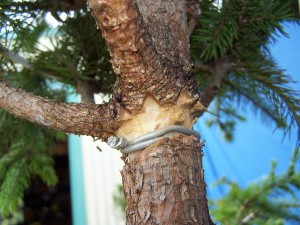This was collected back in 2008 , growing on the side of a cutting it had an exposed tap root and a stay root anchoring it to the ground .With both roots exposed and quite large i did notice some unusual callousing around the base , it had no fine feeder roots close to the main trunk . I severed the 2 roots and gathered some soil and Mycorrhizae from the immediate area and returned home with the tree . I didn’t consider the survival of the tree would not be good however i did pot it up into a wooden training box with red Sc0ria and added extra Mycorrhizae then placed it under a shade cloth cover .It remained there until Winter 09 when i noticed it was still green so i decided to check the roots .After lifting it out of the box only 1 very fine feeder root was present , it was about 900mm long . I used this feeder root as a tourniquet to the base and gently wrapped it around the severed base to create a fine feeder root area ,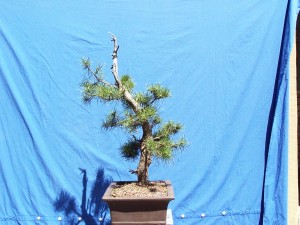 returned it to large terracotta bonsai pot
returned it to large terracotta bonsai pot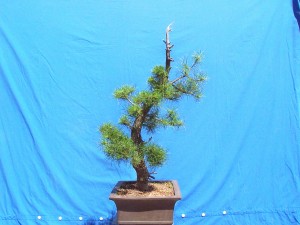 and potted it up with the same mix as the previous year
and potted it up with the same mix as the previous year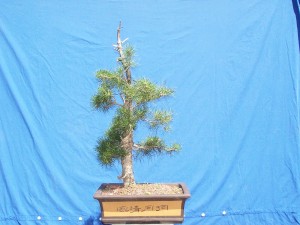 . It has now had a basic pre-styled and is still progressing nicely .
. It has now had a basic pre-styled and is still progressing nicely .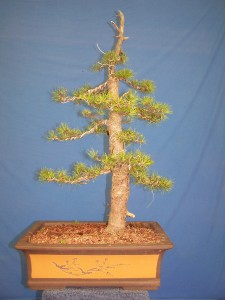 Come Winter i will slip it out of the pot
Come Winter i will slip it out of the pot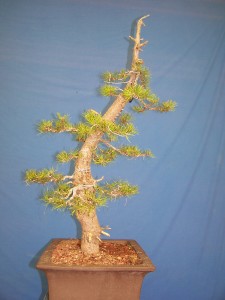 and hopefully find a nice root network
and hopefully find a nice root network 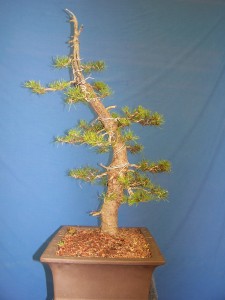 .It will no doubt take many years to establish a good Narebri however i have all the time in the world .The tree itself has had the top jin added as the original apex was straight and lacked character. It was positioned in the training pot to accommodate the large side root , this is not the finished position for the tree. Height of the tree is around 800mm and the base around 65mm in diameter
.It will no doubt take many years to establish a good Narebri however i have all the time in the world .The tree itself has had the top jin added as the original apex was straight and lacked character. It was positioned in the training pot to accommodate the large side root , this is not the finished position for the tree. Height of the tree is around 800mm and the base around 65mm in diameter
Archive for February, 2011
This was in need of a refreshment , 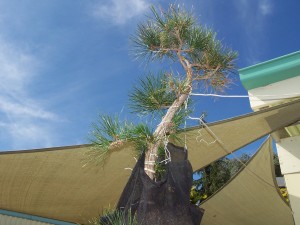 i decided to remove the wire a check the fusing of the trunks .
i decided to remove the wire a check the fusing of the trunks . 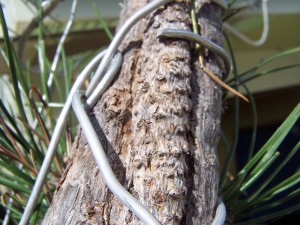 It has worked a treat and the added younger plants were fusing well also
It has worked a treat and the added younger plants were fusing well also 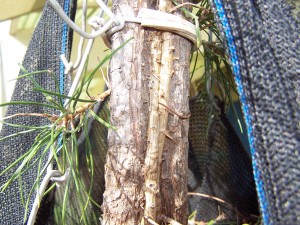 so i decided to inspect the roots to see if and when the top could be removed . Bugger me after scratching around in the soil , i found a couple of curl grubs happily feasting on the new roots . With no time to waste a contacted a pest control Manufacturer, only to find their product had no Guarantee in pots . So the decision was made to severe the top off and do an emergency repot as an aerial repot was far too difficult . After removing the layer and the contaminate soil i was amazed at the vigorous roots
so i decided to inspect the roots to see if and when the top could be removed . Bugger me after scratching around in the soil , i found a couple of curl grubs happily feasting on the new roots . With no time to waste a contacted a pest control Manufacturer, only to find their product had no Guarantee in pots . So the decision was made to severe the top off and do an emergency repot as an aerial repot was far too difficult . After removing the layer and the contaminate soil i was amazed at the vigorous roots 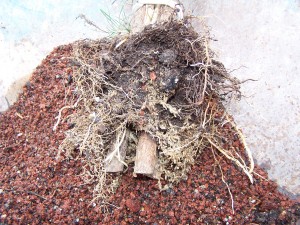 unaffected by the grubs ,
unaffected by the grubs ,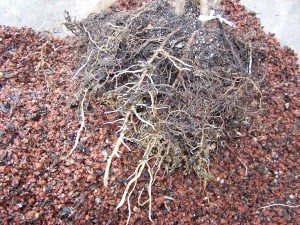 numerous little bugger were found however they were only just starting to grow
numerous little bugger were found however they were only just starting to grow 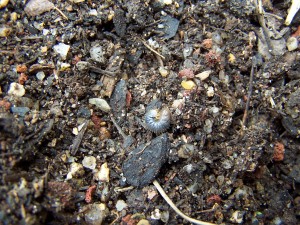 .I soaked the base for an hour or two hoping to drown the horrors , then potted my new tree into a large bonsai pot using Scoria and Mycorrhizae retrieved form the original pots . This bacteria aids root growth and water distribution around the root-ball .Potted up and ready for a new start ,4 guide wires were placed onto the trunk to stabilize the tree, i dont want this one blowing over in the wind . Now all i had to do was to severe the few inarch grafts
.I soaked the base for an hour or two hoping to drown the horrors , then potted my new tree into a large bonsai pot using Scoria and Mycorrhizae retrieved form the original pots . This bacteria aids root growth and water distribution around the root-ball .Potted up and ready for a new start ,4 guide wires were placed onto the trunk to stabilize the tree, i dont want this one blowing over in the wind . Now all i had to do was to severe the few inarch grafts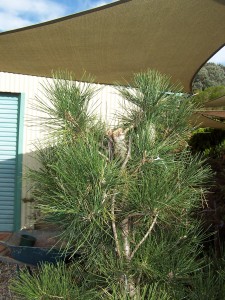 that tied these trunks together and all the original trees would be independant again . These are ready for another set of layers and graft to advance them further as per the trunk already set with layers and inarch grafts
that tied these trunks together and all the original trees would be independant again . These are ready for another set of layers and graft to advance them further as per the trunk already set with layers and inarch grafts 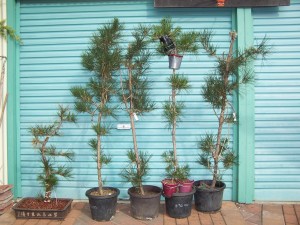 With the apex removed i did set another fuse/inarch graft to my new tree . Cheers and Happy Bonsai.Alpineart
With the apex removed i did set another fuse/inarch graft to my new tree . Cheers and Happy Bonsai.Alpineart
This was 1 of 2 recent purchases from Melbourne . The owners had grown tired of their Christmas Trees Picea Abies or Norway spruce , and i was fortunate enough to be in the right place at the right time .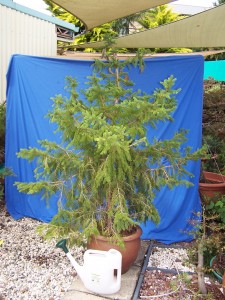 Urban Yamadori or potted plants a terrific for bonsai material .I estimate these to be around 15-20 years old, at 2m high , they have plenty of life in them . I have decided to layer the top off both trees however only one will be used for this demo . Deciding on a suitable whorl to place the layer below , a ring bark was cut , then a few notches taken out of the upper section the increase the area for the roots to sprout from .A wire tourniquet was also attached to assist the callous to send the roots out from the trunk and prevent it from healing over .
Urban Yamadori or potted plants a terrific for bonsai material .I estimate these to be around 15-20 years old, at 2m high , they have plenty of life in them . I have decided to layer the top off both trees however only one will be used for this demo . Deciding on a suitable whorl to place the layer below , a ring bark was cut , then a few notches taken out of the upper section the increase the area for the roots to sprout from .A wire tourniquet was also attached to assist the callous to send the roots out from the trunk and prevent it from healing over .
I used some Hormone powder mixed to a paste for ease of application then applied to the upper section of the layer . I have used Hormone Jel in the past however i prefer the powder it doesn’t wash away in the initial watering . With the layer all set and ready i split a large pot and cut a section out for the trunk , then drill a series of holes around the lower section for drainage and air flow to aid the root growth . 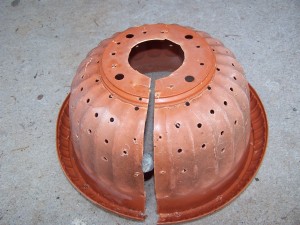 .A mixture of 70% Soft red Scoria , 20% Spagnum Moss and 10% pine bark and Mycorrhizae .
.A mixture of 70% Soft red Scoria , 20% Spagnum Moss and 10% pine bark and Mycorrhizae .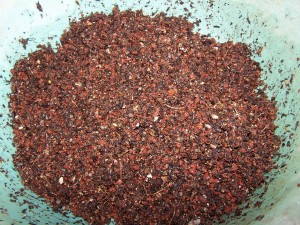 This should be a good mix for root stimulation .It works exceptionally well on pines so there should be no reason it wont achieve good results on these Spruce . The pot is positioned then a aluminium dowel is drilled and inserted through the trunk under the pot to hold the weight of the pot and mix
This should be a good mix for root stimulation .It works exceptionally well on pines so there should be no reason it wont achieve good results on these Spruce . The pot is positioned then a aluminium dowel is drilled and inserted through the trunk under the pot to hold the weight of the pot and mix 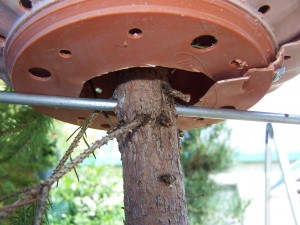 , approximately 5 kgs . An insert of mesh was trimmed and laid inside the pot around the trunk to prevent the medium from falling/washing out . The mix is added and the layer is set for a season or two .
, approximately 5 kgs . An insert of mesh was trimmed and laid inside the pot around the trunk to prevent the medium from falling/washing out . The mix is added and the layer is set for a season or two . 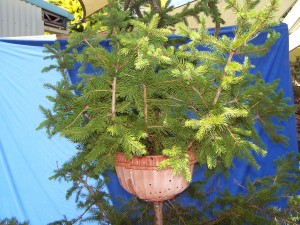 A quick water with a seasol solution and i move onto the lower section . A quick reduction of the lower foliage ,
A quick water with a seasol solution and i move onto the lower section . A quick reduction of the lower foliage , 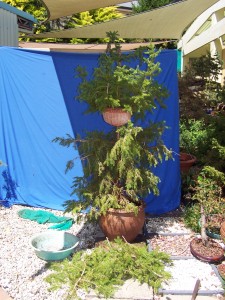 removal of the cones
removal of the cones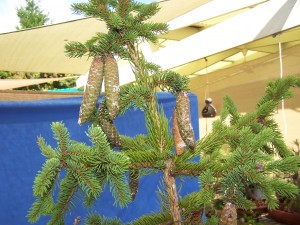 and add a wire tourniquet to the ends of the reduced/trimmed branches to prevent them from bleeding sap
and add a wire tourniquet to the ends of the reduced/trimmed branches to prevent them from bleeding sap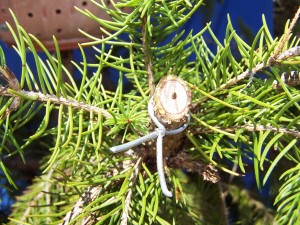 and taking energy from the plant . This will now be left to its own device and watered to prevent drying out . At a later stage, possibly mid Winter an initial style will take place on the lower trunk .For now its onto Tree number 2 .Cheers Alpineart
and taking energy from the plant . This will now be left to its own device and watered to prevent drying out . At a later stage, possibly mid Winter an initial style will take place on the lower trunk .For now its onto Tree number 2 .Cheers Alpineart

